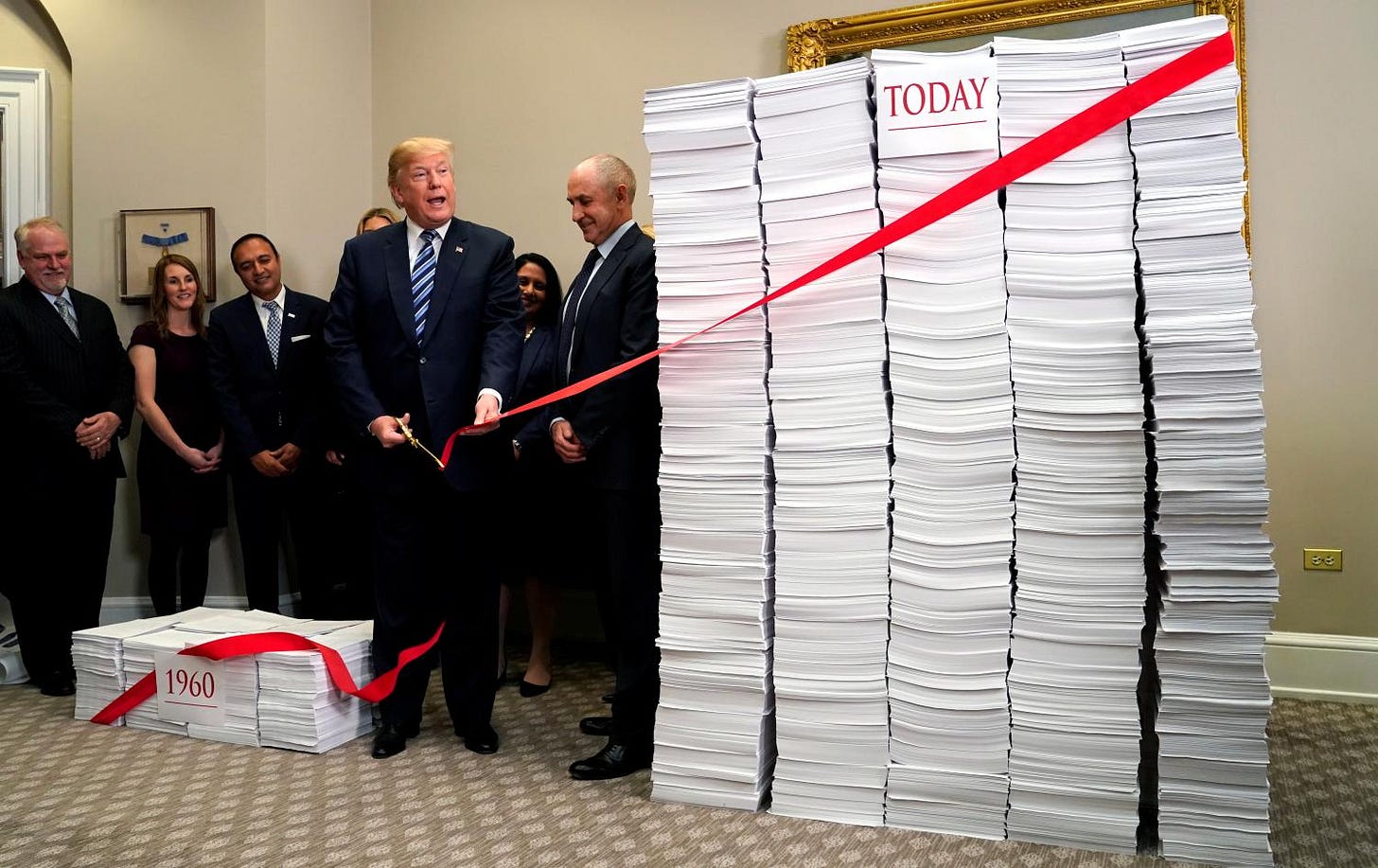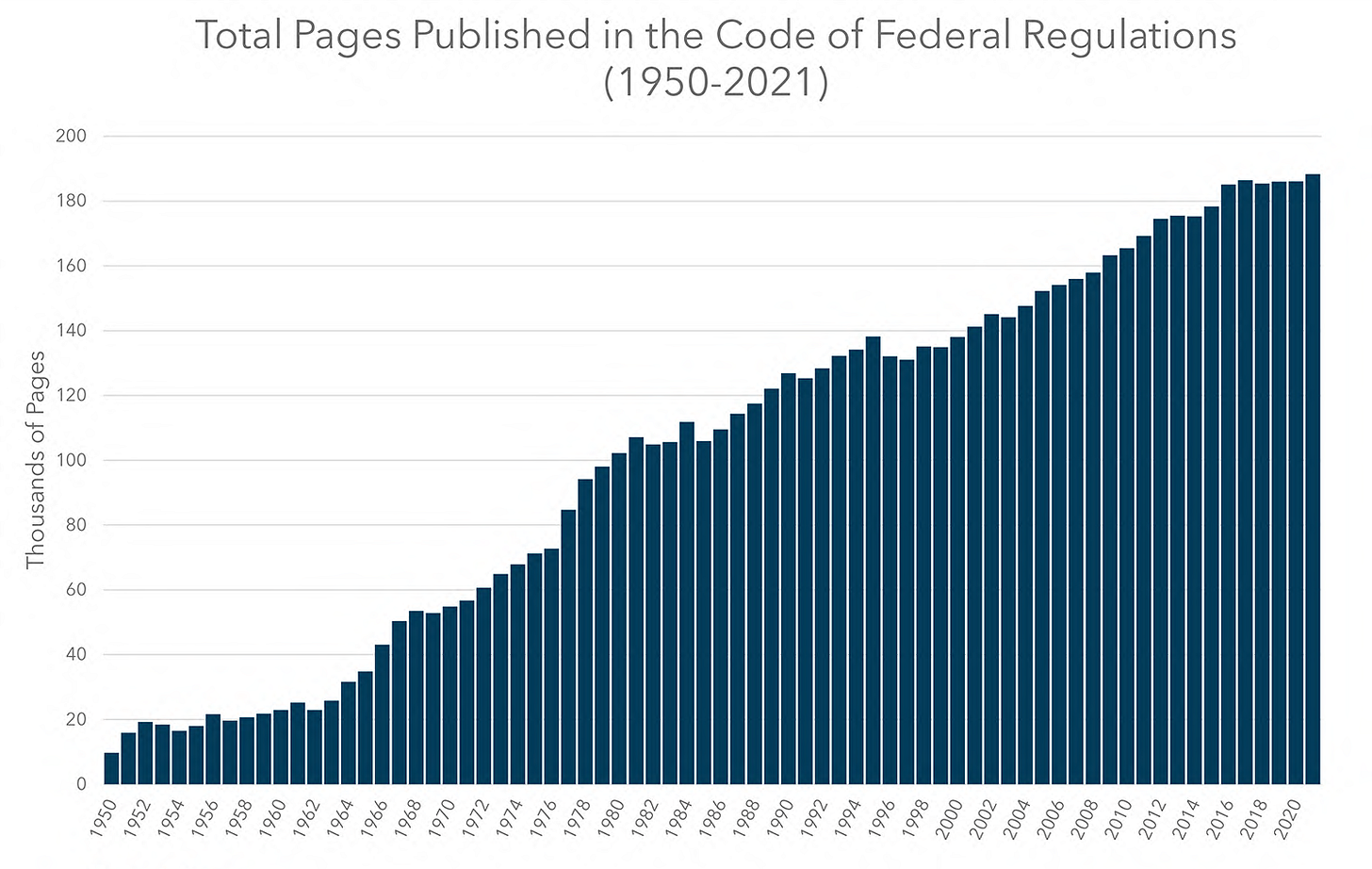How Loper Bright Gives Trump the Tools to Dismantle the Bureaucratic State
America's body of laws has swollen into an unwieldy labyrinth that even the most seasoned civil servant struggles to navigate. From the 9,745 pages of the Code of Federal Regulations (CFR) in 1950 to a staggering 200,000 pages by 2023, the explosion in regulatory output has fundamentally altered the landscape of governance. For every page of statutory law passed by Congress, federal agencies have added over 20 pages of additional regulations and rules, illustrating the enormity of the administrative state. A glance at more recent data suggests this trend has only accelerated, marking an exponential rise in regulatory expansion over the last few decades. This is not just a matter of red tape—it is a crisis of democratic governance and accountability
A Nation of Laws—Drowning in Rules
America prides itself on being a nation of laws. It’s a phrase that evokes order, justice, and accountability. The statutory laws passed by Congress, our elected representatives, embody the will of the people. They reflect the debates, compromises, and democratic processes fundamental to republican governance. However, statutory law is only one piece of the puzzle. The reality is that the majority of what impacts Americans day-to-day is not statutory law at all, but rather an ever-growing body of administrative rules drafted by unelected and largely unaccountable federal agencies. This is where we find the true crisis: we have too many laws, and worse still, most of them aren’t laws in the traditional sense at all.
These dubious “rules”, written by bureaucrats ensconced in Washington offices, have become the de facto law of the land. Under the guise of interpreting Congress's intent, agencies write regulations that expand their authority and control over vast aspects of American life—often beyond anything Congress could have reasonably envisioned. This unchecked delegation of power to the bureaucratic apparatus presents the most profound threat to democracy today. These agencies are neither elected by nor accountable to the American people, yet they wield a tremendous amount of influence over how our nation is governed.
The Chevron Problem: An Unelected Bureaucracy Empowered
This problem of bureaucratic overreach has, for decades, been protected by a judicial doctrine known as Chevron deference. The 1984 Supreme Court decision in Chevron U.S.A., Inc. v. Natural Resources Defense Council, Inc. established a framework whereby courts should defer to federal agencies' interpretations of ambiguous statutes, as long as those interpretations were deemed "reasonable." This meant that when Congress's language was vague, courts would side with the agency, rather than interpreting the statute independently. As a result, the executive branch amassed incredible power to create, define, and enforce regulations, effectively creating new “laws” without any direct legislative approval.
Loper Bright Enterprises v. Raimondo: A Turning Point for Accountability
All of this changed in June of this year, with the Supreme Court decision in Loper Bright Enterprises v. Raimondo, a landmark ruling that overruled the Chevron precedent. In this case, the Court rightly recognized the folly in deferring blindly to bureaucratic agencies, whose interpretations often expand their own power at the expense of both the legislature and the citizens. The end of Chevron deference represents a vital course correction—an opportunity to strip away layers of excessive regulations and restore the intended balance of power between the branches of government.
This decision has given the incoming Trump administration a clear mandate: to roll back decades of unchecked regulatory growth, restore authority to the American people through their elected representatives, and eliminate bloated rules that have hindered American commerce and personal liberty. Trump should seize this opportunity to sign an executive order requiring every federal agency to proactively review every regulation in their portfolio—not merely to manage these regulations, but to eliminate those that were never meant to exist in the first place. Every regulation or rule that wasn't explicitly legislated by Congress should be removed, and if this creates issues, Congress can pass updated legislation as needed.
The Trump Plan: Reviewing and Removing Regulatory Bloat
During his first term, President Trump made significant strides toward reducing regulatory burdens, famously standing in front of towering stacks of regulations, cutting a ribbon to symbolize the end of bureaucratic excess. Despite these efforts, the administrative state retained many overreaching rules due to Chevron deference, which allowed agencies to interpret ambiguous statutes as they saw fit.
Now, with the Loper Bright Enterprises v. Raimondo decision overturning Chevron, Trump has been given a powerful tool that was previously unavailable: a mandate for agencies to fix their overburdensome regulations. President Trump should immediately direct federal agencies to conduct a comprehensive review of all existing regulations with an eye toward eliminating any that relied on Chevron-based reasoning. Agencies should begin by prioritizing regulations that have been the subject of litigation—those that Americans have challenged in court, but where the agency prevailed solely because of Chevron deference. This will ensure that the regulations most obviously in conflict with statutory authority are removed first, particularly those that have burdened American families, small businesses, and industries.
Consider cases like National Cable & Telecommunications Association v. Brand X or EPA v. EME Homer City Generation. In these examples, the agencies won in court, not because Congress explicitly granted the power they exercised, but because Chevron deference gave them the benefit of the doubt. It is time to take back that benefit and return it to the American people. For instance, in Brand X, the FCC's classification of broadband services as "information services" rather than "telecommunications services" created a regulatory environment that benefited major ISPs at the expense of competition and consumer choice. Such regulations, which never had a direct legislative mandate, should be high on the chopping block.
Targeting the Most Costly Regulations
Beyond court-challenged regulations, agencies should also focus on the regulations that impose the highest costs on American businesses and families. Studies have shown that overregulation stifles economic growth, restricts job creation, and disproportionately impacts small businesses, which lack the legal and financial resources to navigate complex regulatory frameworks. In fact, overburdensome regulations are estimated to cost American businesses and families approximately $2 trillion annually in compliance costs. By slashing the number of pages in the Code of Federal Regulations, the Trump administration can deliver a direct and tangible economic benefit to Americans, increasing growth and giving power back to entrepreneurs rather than bureaucrats.
Incentivizing Change: A Bounty Program for Civil Servants
Finally, to ensure that this ambitious rollback of regulatory bloat is executed effectively, the Trump administration should consider implementing a bounty/bonus program for civil service employees who achieve measurable reductions in regulatory volume. Federal agencies currently operate with a mindset that more regulation equals better governance. It is time to turn that thinking on its head. By setting a target—for instance, reducing the ratio of regulatory pages to statutory pages from 20:1 to something much lower—and offering financial incentives for achieving these reductions by a set date, we can align the motivations of federal employees with the priorities of the American people.
Additionally, each cabinet head should publicly report their Key Performance Indicators (KPIs) on their agency's website, including the number of pages of regulations they started with on January 20th and how much reduction they have achieved daily, monthly, and yearly. They should also estimate the savings their efforts have provided to the American people and businesses. Highlighting civil servants who contribute most significantly to cutting regulations could further foster an atmosphere of accountability and recognition. This data from each agency would roll up to the Department of Government Efficiency for a global view of the progress made by each agency. The agencies should be ranked against one another—creating a competitive environment aimed at reducing regulatory burden efficiently and transparently.
Those who succeed in eliminating unnecessary rules should be rewarded for doing so. After all, less regulation means more liberty, and a more efficient, responsive government.
A Nation of Laws, Not Bureaucrats
Ultimately, the solution is simple: we need to return to being a nation of laws as written by Congress, not a nation governed by the whims of unelected officials. Loper Bright Enterprises v. Raimondo has handed us the tools to do just that. Now it is time for the Trump administration to take those tools and dismantle the bureaucratic leviathan that has grown far beyond its original remit. We must cut through the regulatory thicket that has strangled innovation, throttled economic growth, and undermined the democratic process.
The work ahead is not just about reducing page counts; it is about reasserting the foundational principle that power belongs in the hands of the people, exercised through their representatives—not in the hands of faceless, unaccountable administrators. Let us hope that, with this renewed mandate, the Trump administration moves swiftly to restore a government that is truly of the people, by the people, and for the people.
If you don't already, please follow me on 𝕏 at https://x.com/amuse or medium




